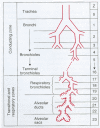Recent advances in the treatment of Pseudomonas aeruginosa infections in cystic fibrosis
- PMID: 21463524
- PMCID: PMC3087692
- DOI: 10.1186/1741-7015-9-32
Recent advances in the treatment of Pseudomonas aeruginosa infections in cystic fibrosis
Abstract
Chronic Pseudomonas aeruginosa lung infection in cystic fibrosis (CF) patients is caused by biofilm-growing mucoid strains. Biofilms can be prevented by early aggressive antibiotic prophylaxis or therapy, and they can be treated by chronic suppressive therapy. New results from one small trial suggest that addition of oral ciprofloxacin to inhaled tobramycin may reduce lung inflammation. Clinical trials with new formulations of old antibiotics for inhalation therapy (aztreonam lysine) against chronic P. aeruginosa infection improved patient-reported outcome, lung function, time to acute exacerbations and sputum density of P. aeruginosa. Other drugs such as quinolones are currently under investigation for inhalation therapy. A trial of the use of anti-Pseudomonas antibiotics for long-term prophylaxis showed no effect in patients who were not already infected. Use of azithromycin to treat CF patients without P. aeruginosa infection did not improve lung function. Here I review the recent advances in the treatment of P. aeruginosa lung infections with a focus on inhalation treatments targeted at prophylaxis and chronic suppressive therapy.
Figures
References
-
- Høiby N, Krogh Johansen H, Moser C, Song Z, Ciofu O, Kharazmi A. Pseudomonas aeruginosa and the in vitro and in vivo biofilm mode of growth. Microbes Infect. 2001;3:23–35. - PubMed
-
- Høiby N, Pressler T. Emerging pathogens in cystic fibrosis. Eur Respir Mon. 2006;35:66–78.
Publication types
MeSH terms
Substances
LinkOut - more resources
Full Text Sources
Other Literature Sources
Medical


